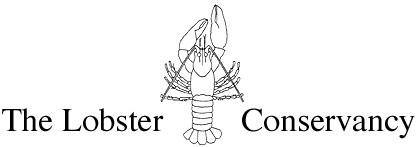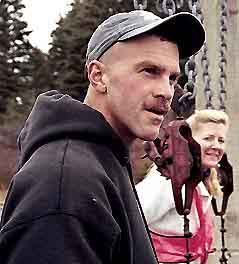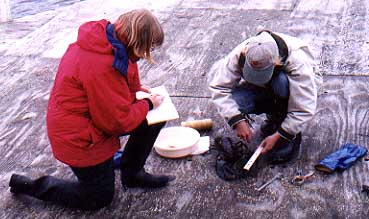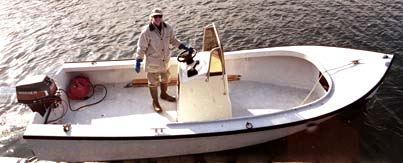
P.O. Box 235, Friendship, ME 04547 (207) 832-8224 www.lobsters.org

P.O. Box 235, Friendship, ME 04547 (207) 832-8224 www.lobsters.org
March 8, 2000
Dear Volunteers and Friends of The Lobster Conservancy,
As winter comes to a close, we thought it was high time we wrote to let you know how we survived our first winter in Friendship and to get you thinking about the fast approaching Intertidal Lobster Monitoring season! We have some big plans for expansion.Research News
Juvenile Lobsters
We are thrilled to report that The Lobster Conservancy's Intertidal Lobster Monitoring Program is being well supported for the Year 2000. Our goal is to continue monitoring at most of our existing sites, while adding new sites in Massachusetts, New Hampshire, and southern Maine. This will be possible thanks to a grant from the National Fish and Wildlife Foundation as well as matching funds from the Greater Piscataqua Community Foundation and Darden Environmental Foundation. We are still in the process of raising additional matching funds.
Volunteers have been taking a well-deserved break from intertidal monitoring during the winter months. The new monitoring season is approaching quickly, so Sara will be contacting individuals to seek comments and suggestions based on last year's experiences and to discuss long-term participation.
One of the interesting results of last year's work around Penobscot Bay was that patterns of lobster abundance being documented by volunteers in the intertidal zone mirror the patterns seen underwater in the subtidal zone. To test this, we compared densities of small juvenile lobsters (< 40 mm carapace length) at 13 sites around Pen Bay where data were collected in the intertidal zone by TLC volunteers and in the subtidal zone by SCUBA divers working with Dr. Bob Steneck at the University of Maine. There was a strong correlation (r = 0.9) (see chart). This lends support to our assertion that volunteer-based intertidal monitoring is an effective, low-cost monitoring technique that can be used to study lobster populations over time and space.
As reported last fall, Diane stopped tagging lobsters at her long-term study site Lowell's Cove, in Casco Bay, although she will still be recapturing tagged lobsters there during monthly surveys. Although the data collected to date at Lowell's Cove are abundant and offer keen insights into lobster early life, the study has been restricted to one location. Because lobster growth rates are influenced by environmental conditions, it will be beneficial to compare the results of the Casco Bay study to other locations. We are therefore proposing to add two sites in Muscongus Bay — Friendship Long Island and Allen Island— to our tagging study.
In November, Sara and Diane went to the new tagging site in Lobster Gut on Friendship Long Island to establish transect lines for repeated quantitative sampling. Diane returned to the site in December to start tagging lobsters. Young-of-the-year and early juveniles were abundant both months. Foul weather prevented sampling in January and February. Lobsters autotomize (throw) their limbs if they are stressed when air temperatures are exceedingly low. Although they grow them back during the next molt, we decided to let them be for the time being. This spring, Diane plans to train TLC volunteer Mike Wall to tag lobsters on Allen Island. In preparation for this new project, Mike visited the Friendship Lobster Laboratory and Lowell's Cove last November to learn about the rigorous laboratory and field components of the tagging research.

Mike Wall visited the Friendship Lobster Lab to learn about tagging techniques. Photo by Sara Ellis.
Adult Lobsters
At the Friendship Lobster Laboratory, we managed this winter to drop the metal plates and close the sluice gates to prevent the tide from emptying water out of the lobster pound. This was in preparation for our pilot tagging studies on adult lobsters. Diane is the first to admit it remains a bit unnerving to look out and see so much water in the pound when it's supposed to be low tide. After so many years of living by the tides, she has come to depend on the water's flow and ebb to mark time. Here, it no longer ebbs very far, so the cycle is way off kilter.
Before closing the gates, a volunteer team of well-equipped students from the University of Maine at Orono came out to survey the dimensions and depth contours of the pound. We greatly appreciate the efforts of Steve Doughty, Valerie Carney, Ted Wells, Brian Naberezny, Ashton Lamont, Chris Bailey, and Joshua Connell who are applying what they've learned at UMO's Department of Spatial Information Science and Engineering.

Students from the University of Maine at Orono surveyed the lobster pound. Photo by Diane Cowan.
We will use the map they produce as a reference for plotting the placement of lobster shelters and then for taking census observations of the lobster locations in the pound. The modified map will serve as a data sheet to note where each lobster is located and what it is doing at any given time.
After closing the gates, we put some lobsters inside for the winter. Each lobster was individually marked using an internal and an external tag. We are testing the efficacy of the internal tag to make sure the lobsters can retain it throughout the molt cycle. The external tags are being tested for their ability to withstand corrosion. The lobsters for this pilot study were donated thanks to Friendship lobstermen Kevin Benner (FV Wanda Marie) and Henry Thompson (FV Ashbri). We have fed these lobsters and monitored their well-being periodically throughout the winter. They are surviving well. Working with the experimental lobsters is made possible thanks to the Maine Department of Marine Resources Lobster Advisory Council who granted a research permit to capture and hold oversized lobsters. The Davis Conservation Foundation provided modest funding for the tagging project.

TLC scientists have begun pilot tagging studies on oversized lobsters. Photo by Rod Pratt.
Author John Richardson and photographer Gordon Chibroski (Portland Press Herald) braved the bone chilling January weather to learn and publicize what was happening at the pound as it started to freeze over (http://www.lobsters.org/press/press.php). It was especially rewarding to show off the Friendship Lobster Laboratory to John and Gordy because they published The Lobster Conservancy's first news back when we were founded. It was rewarding to perceive their appreciation of how far we've come since then. Thank you for your support of our efforts throughout TLC's formative years.
Friendship Lobster Laboratory: Facilities News
Our ability to keep the Friendship Lobster Laboratory up and running during the winter months has been made possible in part by Marty Benner who put in a mooring for our latest boat. The hull of the Aeolidea came with the property; the outboard motor came with the Upton's Girl (donated by John Upton); the resulting marriage is a good rugged, sturdy boat. The launching of Aeolidea marked the hauling and winterizing of Awe Spray. Many thanks to board member Carl Anderson and his son for helping with Awe Spray.

Workboat Aeolidea was launched on December 3, 1999. Photo by Sara Ellis.
Our island neighbors Miles and Stephanie Jamieson helped out with various advice on winter island living. They also came by with a wood splitter towed by their tractor when our fuel supply got dangerously low and provided welcomed camaraderie in late February. Thanks for that and for the books you loaned!
Outreach and Education News
In November 1999, Amy Watson, a long-time TLC volunteer at Cundy's Harbor, was invited to speak at a volunteer gathering for Friends of Casco Bay, to give a volunteer's perspective on TLC's monitoring program. Amy was a very engaging and genuine speaker and fan mail is still trickling in to this day! As a result of her talk, Amy has been asked to speak at Harpswell Islands School later this spring. You go, Girl!
Since April 1999, Diane has been writing a monthly column called "The Lobster Doc" in Commercial Fisheries News. The main goal of "The Lobster Doc" is to give handling tips and information about the basic biology of lobsters that may help lobstermen increase the value of their product. These articles have been well received and are being reprinted in other industry publications. Thank you to TLC volunteer Al Stewart for posting the articles on our web site (http://www.lobsters.org/ldoc/ldocindx.php).
In March, Diane, Sara and Amy went to the Maine Fishermen's Forum, to attend presentations and meet up with friends and colleagues. Philip Conkling of the Island Institute gave a presentation summarizing research of the Penobscot Bay Lobster Collaborative, including work by TLC volunteers in Pen Bay.
Fundraising
We'd like to close by saying a huge thank you to those of you who were able to respond to our First Annual Campaign. As our organization grows so does our need for new sources of support, and donations of any size are very helpful. We also greatly appreciate non-financial contributions such as the valuable time that our volunteers contribute to our monitoring program. Thanks go to Susan March and Nancy Appel-Boothby for helping set up our mailing list, and to Charlie Leadbetter, Lois Martin and other staff at the accounting firm Berry, Dunn, McNeil and Parker for actually sending out the mailing.
If you did not receive our Campaign letter, it means we don't have your correct snail-mail address in our files. Please let us know if you would like to receive future mailings by sending us your current address.
Yours in TLC and Friendship,
Sara Ellis, Executive Director and Diane Cowan, Senior Scientist